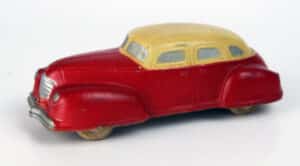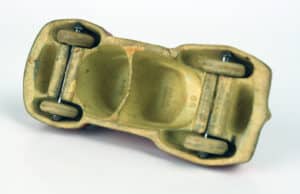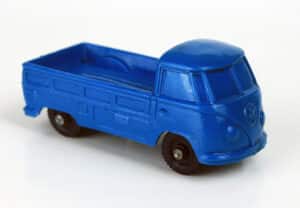by Douglas R. Kelly

Until a month ago, as I was browsing the aisles at the Allentown Antique Toy Show in Pennsylvania. The show had just opened to early buyers, and I had already scored a beautiful tinplate Minic town car and was waiting as the seller wrapped it up and placed it in a bag for me. My eyes wandered over other toys on display in the booth, stopping when they landed on this red and yellow rubber sedan. Normally I’d have passed right over it, but this example was in exceptional original condition. It also was straight (not warped as many rubber toy cars are), and a look at the underside showed no cracks or missing paint.

I’m surprised it caught my eye, actually, because, like many other rubber toys made in the 1930s and 1940s, it has closed-wheel arches. This tends to annoy me as I like to see a vehicle’s wheels, and covered arches often spoil the lines of a toy or model car. This one is 4.25 inches long and, after 80-plus years of life here on Earth, it’s quite brittle and hard. It was made by the Ohio-based Sun Rubber Company, which also turned out rubber trucks, race cars, tractors, and buses. This one is based on a real car, the 1940 Dodge sedan, and, for the time being, it’s a pretty decent replica. Except—again—for those covered arches. I realized I was “buying the condition,” but I have to say that this little sedan spoke to me in that 1930s dialect that makes me weak in the knees and I handed over the $25 asking price without a struggle.
Where this one will wind up on display in our toy room, I don’t know, but it won’t be alone because all of this happened again just two weeks later. We were in Boston to visit our daughter, and we happened upon a small antique shop that at first appeared to be closed. After the owner waved to us from inside, we went in to look around. The shop was quite chilly, but it contained a good mix of pop culture items along with the glass and clothing, so I figured it was time well spent.

When the owner told me the price was $40, I put the VW back on the shelf. He asked me what I’d pay, so I told him $20, and he said, ”Sounds good.” Unfortunately, he only took cash, and I didn’t have enough in my wallet to close the deal. Later that day, we mentioned all of this to our daughter’s roommate, who told us that the owner of the shop was a friend and that she was headed that way on an errand. Did I want her to stop in and buy the VW? I told her no, please don’t go out of your way for that. She said no worries, but a couple of hours later returned with the VW pickup in a small bag. What a sweet thing for her to do, and I was pleased as punch to have the VW.
Two rubber toys in two weeks. I’m growing.
Douglas R. Kelly is the editor of Marine Technology magazine. His byline has appeared in Antiques Roadshow Insider; Back Issue; Diecast Collector; RetroFan; and Buildings magazines.





Related posts: